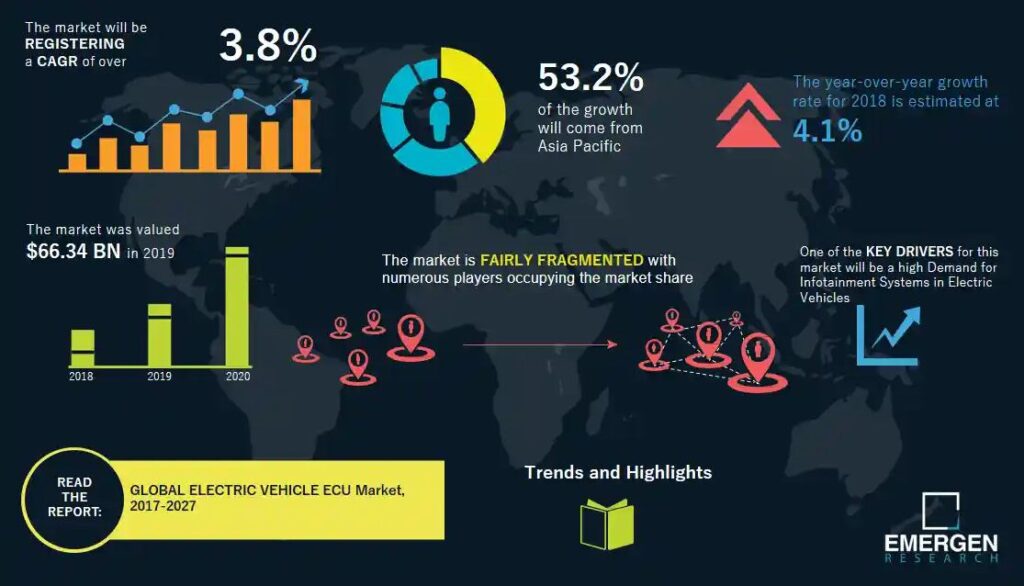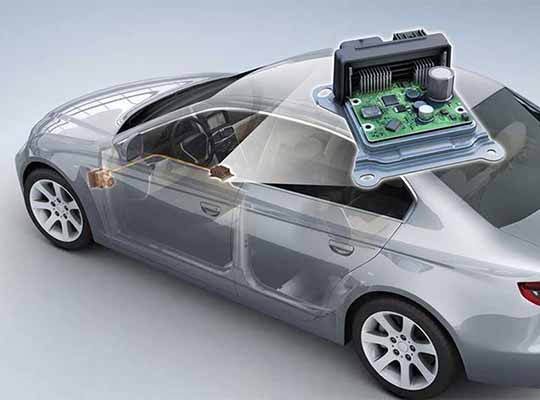According to a recent analysis by Emergen Research, the global electric vehicle control unit market is anticipated to reach USD 42.74 billion by 2027. Among the key drivers propelling the expansion of the electric vehicle ECU market are the rising demand for electric passenger vehicles, the increased use of infotainment systems, and the rising tendency for ADAS and automatic protection systems. The average number of electronic control units (ECUs) used in electric vehicles has increased significantly in addition to a rise in the number of electronic components to perform improved functionality of dashboard instruments, engine, telematics, and powertrain operations.
It is anticipated that a number of safety technologies, such as adaptive cruise control, adaptive front illumination, and anti-lock braking, will be implemented as part of supportive legislation from governmental and regulatory agencies to improve road safety. To ensure that layer design and layer construction between the ECU hardware and application software can be standardised, the AUTOSAR Alliance was recently established. The New Car Assessment European Program was established to reduce the likelihood of accidents by enabling automakers to incorporate lane-departure warnings and lock-resistant braking systems into their manufacturing processes. This will improve the hardware and software integration’s scalability and adaptability.

Driver: Increasing popularity of electric cars
The growing demand for electric vehicles is one of the major factors influencing the vehicle control unit market. Because electric vehicles include integrated electronics, a supervisory controller is needed to coordinate with all of the ECUs inside the car. The integrated system of vehicles is balanced, controlled, and optimised by VCUs, improving overall functionality. VCU offers powertrain solutions and aids in the analysis of the battery and charging conditions for electric vehicles. Thus, the market for vehicle control units will grow as the automotive industry shifts more toward electric vehicles.
Caution: Significant investments are needed
The expense of developing a VCU or the investment needed to produce one would be the main barrier to the expansion of the vehicle control unit market. VCUs are pricey because of their cutting-edge technology. Any VCU’s R&D phase requires a number of test runs. Additionally, every VCU supplier is creating specialised hardware and software for the university. They are therefore more expensive than any mechanical item. Long-standing automakers are investing a lot of effort and money into creating VCUs that can be used in their own vehicles.
Opportunity: Growing interest in cutting-edge technologies
Software technologies have advanced as a result of the advent of autonomous vehicles. The car’s cockpit now has a number of additional features. Battery management software, sophisticated gesture controls, a reversible instrument cluster, and a charging indicator are some of these. The majority of ultra-premium and premium cars include two or more distinctive displays that show information on the HVAC, parking, infotainment, and vehicle diagnostics.
Challenge: Potential for total failure Even though VCU regulates and improves the entire vehicle system, a total system failure is always a possibility. Any flaw in the hardware or software could cause the entire system to fail or crash. The working and environmental conditions are just two of the many variables that might have an impact on how VCU operates. It is not as durable and strong as a mechanical component because it is an embedded electronic device. A VCU is also linked to and reliant on the quantity of sensors spread throughout the vehicle.
Some Key Highlights from the Report
- By capacity, the 32-bit electric vehicle ECU sub-segment contributed to the largest market share in 2019. The 32-bit ECU components are primarily deployed in automotive parts attributed to the accompanying advantages such as the necessity of low power for operation and design simplifications.
- By vehicle type, the commercial vehicle segment is likely to grow at a rate of 36.6% in the forecast period, owing to the rising incorporation of electric vehicles in commercial fleets, as well as increasing concern among fleet owners for the safety and security of the vehicle during transit.
- By propulsion type, hybrid vehicles held a larger market share in 2019, as they are powered by both fuel and battery. Conversely, the BEVs are projected to witness a faster growth rate in the period 2020-2027.
- By application, ADAS & safety systems, in terms of market size, dominated the electric vehicle ECU market in 2019. ADAS is the most demanding application, in terms of processing power, owing to its beneficial features comprising obstacle detection, lane departure warning & change assistance, juncture collision warning, and rollover & rear impact warning, among others for offering protection to the in-car passengers and common public.
- The market in the Asia Pacific region accounted for a revenue of USD 1,600.4 Million in 2019. The market dominance of the APAC region, led by China, is due to massive investments by developing countries in the development and production of electric vehicles, thus driving the market for ECUs. The region is also expected to create substantial opportunities with continuous technological advancements to reduce the ECU count per vehicle.
- Key participants include Altera, Atmel Corporation, Continental AG, DELPHI Technologies, Denso Corporation, Autoliv Inc., Dow Corning Corporation, Hitachi Automotive Systems, Ltd., Hella KGaA Hueck & Co., and Hyundai Mobis, among others.











